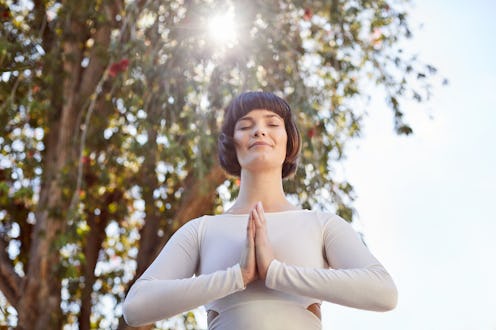Fitness
Mountain Pose Is The Grounding Yoga Posture You Can Do Anywhere
Pop into it whenever you need a dose of peace.

While child’s pose is undeniably relaxing, it isn’t the type of move you can drop into at the grocery store. If you’re looking for a chill yoga pose you can do anytime, anywhere, standing postures like mountain pose are a way better bet — and this one is just as grounding.
Mountain pose, also known as tadasana, is a standing posture that forms the foundation for many other poses, says Brandt Passalacqua, the founder, director, and lead teacher at Breathing Deeply Yoga Therapy. It’s also one you can easily pop into whenever you need a dose of peace. “With your feet firmly planted on the ground, your body standing tall, and your awareness heightened, mountain pose is an especially grounding pose,” he tells Bustle. “It creates a sense of stability within your body and connection with the ground beneath your feet.”
It’s a good one to try in the morning so you feel rooted and calm before you start your day, and it’s also one you can do while waiting for the bus, in the grocery line, or during work breaks. “You can make the most of your time by aligning your body and practicing good posture with mountain pose,” Passalacqua says. “Use it to center yourself when you’re feeling stressed.”
Mountain pose will also improve your balance and bodily alignment. The more you practice standing up straight, the easier it’ll be to maintain good posture even when you aren’t doing yoga. “It also engages your different muscle groups, lengthens your spine, and can help to strengthen your lower body,” Passalacqua adds. As you stand tall, you’ll feel the muscles in your core, calves, and even in your feet.
Read on for exactly how to give mountain pose a try.
How To Do Mountain Pose
Here, Passalacqua explains how to do mountain pose with good form.
- Stand with your feet hip-width apart.
- Let your arms hang comfortably at your sides with your palms facing forward.
- Engage the muscles in your legs.
- Feel how your feet are rooted down to the floor.
- Be careful not to lock your knees.
- Engage your core muscles.
- Open your chest by rolling your shoulders back and down.
- Stand tall and lengthen up through your spine.
- Hold for five to 10 breaths.
How To Modify Mountain Pose
To make your mountain pose a little more stable, feel free to step your feet slightly wider than hip-width apart to create a sturdier base. You can also hold onto a chair or touch a hand to the wall for extra support, Passalacqua says.
To get your posture right, try standing with your back against the wall so you can feel the correct alignment, he adds. To modify even more, you could try doing mountain pose in a chair by sitting up straight, placing both feet on the floor, and taking deep breaths.
“For those who want to do more with mountain pose, lace your fingers together in front of you with your palms facing outward and reach out with your arms to stretch your arms and shoulders,” Passalacqua says. “You can also perform mountain pose with your eyes closed to put more emphasis on how your body feels rather than what you can see.” This will also challenge your balancing skills.
To really tap into the grounding aspect of the pose, turn inward and pay attention to how you feel, says Aine Rock, an integrative health coach, yoga teacher, and breathwork healer. “It can seem simple, but it requires your full attention to scan the body and bring energy to all the parts as one,” she tells Bustle. “Focusing your mind on your body this way is a somatic practice that can be calming and soothing for the nervous system, so if you’re feeling agitated or anxious, take a few moments and simply breathe in this simple yet powerful posture.”
Common Mistakes To Avoid
According to Whitney Berger, a certified yoga instructor, personal trainer, and founder of WhitFit NYC, it’s common to lean too far forward or too far back while in mountain pose. To make sure you make the most of the move, she suggests keeping your weight evenly distributed in your feet. It might also help to slightly tuck your hips.
Check that your back is straight and your shoulders are rolled back, too. Not only will this help you feel extra grounded — and strong and tall — but it’ll also do wonders for your posture.
While you’re at it, check to make sure you aren’t clenching any part of your body. The goal is to feel relaxed yet stable, says Passalacqua. It’s also beneficial to give yourself time, when you can, to really enjoy this pose. If you can hang out in it for a few minutes, it’ll be even more relaxing.
Studies referenced:
Basu-Ray, I. (2021). A Mechanistic Model for Yoga as a Preventive and Therapeutic Modality. International Journal of Yoga. doi: 10.4103/ijoy.IJOY_136_20.
Golec de Zavala, A. (2017). Yoga Poses Increase Subjective Energy and State Self-Esteem in Comparison to 'Power Poses'. Frontiers in Psychology. doi: 10.3389/fpsyg.2017.00752.
Sources:
Brandt Passalacqua, founder, director, lead teacher at Breathing Deeply Yoga Therapy
Aine Rock, integrative health coach, yoga teacher, breathwork healer
Whitney Berger, certified yoga instructor, personal trainer, founder of WhitFit NYC
This article was originally published on